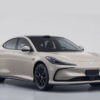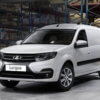In the fourth generation, the popular hatchback acquired the features of a crossover and became more spacious, although it did not grow much in size. The French brand even calls it the most comfortable in its class. The new design and all-electric powertrain distinguish the ë-C3 from its predecessor, and the price of 23,300 euros (2.4 million rubles) makes it one of the most affordable electric vehicles in Europe. An even cheaper version will appear in 2025.
The front of the ë-C3 is designed with an eye to the Oli electric concept car presented a year ago: it borrows the C-shaped headlights with a new oval emblem between them. With the change of platform to the Smart Car from Stellantis, the car grew in length by 19 millimeters and in width by six, making the interior slightly more spacious.
The trunk also holds a little more – 310 liters with the rear row backrests raised versus 300 liters for its predecessor. The ground clearance of the electric ë-C3 corresponds to the new form factor: it is 163 millimeters, which is 28 millimeters more than that of the “third” C3.
Citroen ë-C3
CitroenCitroen ë-C3
Citroen Citroen ë-C3
Citroen ë-C3
Citroen Citroen ë-C3
Citroen ë-C3
Citroen Citroen ë-C3
Citroen ë-C3
Citroen Citroen ë-C3
Citroen ë-C3
Citroen Citroen ë-C3
Citroen ë-C3
Citroen Citroen ë-C3
Citroen ë-C3
Citroen Citroen ë-C3
Citroen ë-C3
Citroen Citroen ë-C3
Citroen ë-C3
Citroen Citroen ë-C3
Citroen ë-C3
Citroen Citroen ë-C3
Citroen ë-C3
Citroen Citroen ë-C3
Citroen ë-C3
Citroen
Comfort, which Citroen focuses on, is ensured by a suspension with Advanced Comfort hydraulic shock absorbers that smooths out road irregularities and new, particularly comfortable seats.
The interior is also special. The so-called C-Zen Lounge is equipped with a 10.25-inch multimedia system display, slightly oriented towards the driver, and a smaller steering wheel. There is no traditional dashboard here: its role is played by a head-up display that displays information on the windshield.
However, the most important changes occurred in the “stuffing”. ICEs have given way to an all-electric powertrain with an electric motor on the front axle producing 113 horsepower. The new product accelerates from zero to 100 kilometers per hour in 11 seconds. The motor is powered by a 44-kilowatt-hour lithium iron phosphate battery, which provides up to 320 kilometers of range and can be charged from 20 to 80 percent in less than half an hour using an express device.
At the start of sales, the ë-C3 will cost European buyers at least 23,300 euros (1.3 million rubles). Next year there will be a cheaper option with a shorter range of about 200 kilometers. The price will be about 19,990 euros (two million rubles), which will make the ë-C3 cheaper than the Dacia Spring, for which they ask from 20,800 euros excluding benefits.
Affordable electric cars: when you save not only on gasoline







